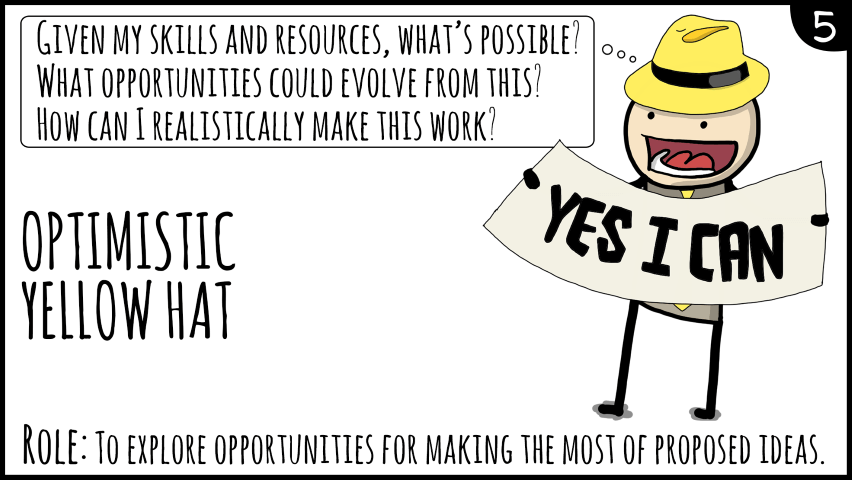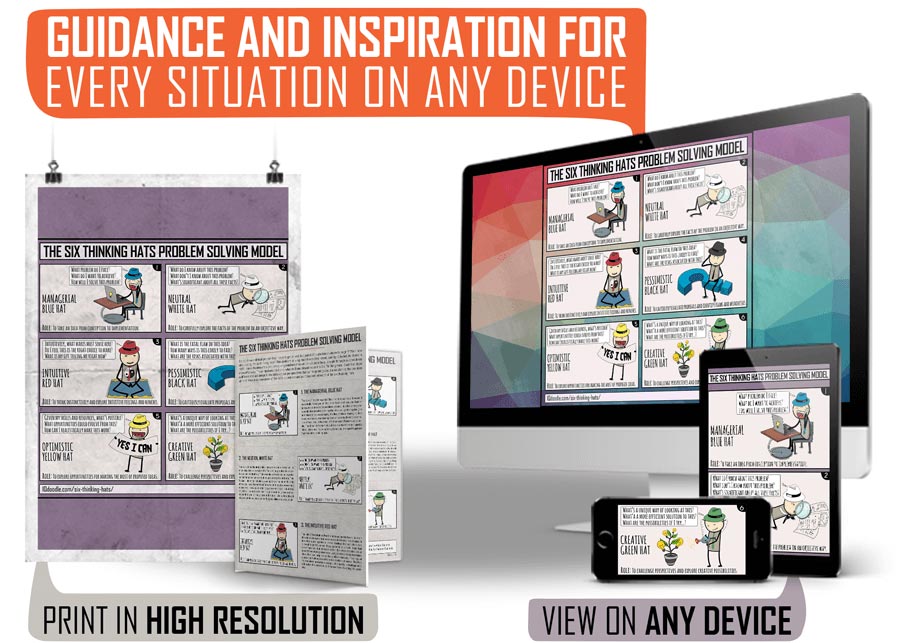Do you have a difficult problem that needs to get solved, but just don’t quite know where to begin? Well, how about using the six thinking hats? This problem solving model was first introduced by Edward de Bono in 1985. It uses the idea of six problem solving mindsets that we can utilize to help us work through our problems more effectively. These mindsets are tied to what de Bono describes as the Six Thinking Hats. Each hat plays a different role and brings to the table various perspectives that can help bring about a solution to the problem at hand. Here is a breakdown of the roles, objectives and purpose behind each of the six thinking hats.
1) THE MANAGERIAL BLUE HAT

The role of the Managerial Blue Hat is to act as a director. It essentially manages all the other hats and ensures that an adequate solution to the problem is found. Its other primary responsibilities involve defining the problem, gathering insights and information, encouraging the flow of ideas, managing time sensitive issues, and moving from an idea to the implementation of that idea in the most effective and efficient way possible. The Blue Hat’s main objectives are therefore to organize ideas, plans and future actions, based on the input it gathers from the other thinking hats.
2) THE NEUTRAL WHITE HAT

The role of the Neutral White Hat is to act as a detective. Its main objective is to explore the facts of the problem in an unbiased and neutral way. This essentially means collecting relevant information, stats and data surrounding the problem. This hat isn’t interested in beliefs, assumptions or opinions. It’s only interested in solid concrete information that can be proven and measured. However, in order to perform this role it must stay objective. It cannot allow itself to get emotionally involved because that would simply corrupt the data. Like a detective, it stays neutral and very open to the possibilities that may exist.
3) THE INTUITIVE RED HAT

The role of the Intuitive Red Hat is to act as the heart. Its main objective is to seek intuitive answers to the problem at hand. It does this by tuning into its internal feelings that can often lead to insights and hunches. Its purpose is to unlock ideas that come from the intuitive heart, rather than from the intellectual head. It therefore preferences using its instincts to formulate ideas that can help move the problem forward. Feelings of course don’t always need to make intellectual sense. The Red Hat therefore never feels compelled to justify its feelings or to rationalize the contribution it makes toward solving the problem.
4) THE PESSIMISTIC BLACK HAT

5) THE OPTIMISTIC YELLOW HAT

The role of the Optimistic Yellow Hat is to act as a sun, or a beacon of light that symbolizes faith and hope. It’s main objective is to take every idea on board and build a case as to why it will succeed, and how it can potentially be implemented. It therefore always looks for the opportunities that may arise from the implementation of an idea. The Yellow Hat of course takes into account the risks, while also assessing the feasibility of getting an idea off the ground. It always however favors possibilities. If there is a will, then the Yellow Hat will always find a way to make things work, irrelevant of the drawbacks that may come to light.
6) THE CREATIVE GREEN HAT

The role of the Creative Green Hat is to act as a seedling. Its main objective is to explore new perspectives and creative ideas that can lead to interesting insights and breakthroughs in thinking. The Green Hat consistently challenges itself to expand possibilities by searching for unique and different ways of doing things. This of course means that they don’t follow traditional rules of thinking, or adhere to standard practices of how things should be done. There are in fact no rules where they’re concerned. The Green Hat will therefore bring many crazy and wacky ideas to the table. Most ideas probably won’t be viable, but some certainly will.
CONCLUDING THOUGHTS
Using the six thinking hats to solve your life problems can provide you with the insights you need to take an idea from conception to implementation.
The six thinking hats are most often used within team environments for group brainstorming purposes, however they can also be used by individuals who are trying to work through a problem.
Working through the six thinking hats would simply involve mentally switching between each of the hats as you explore your problem. This will of course take practice. Each hat brings with it a very different approach to problem solving. Clearly understanding the role and objectives of each of the six thinking hats in advance, can help you to utilize them in more optimal ways as you work through your problem.
Imagine for a moment you could develop new habits and methods of thinking where you naturally and effortlessly adopt these ideas into your life. How would that make you feel? Would you feel more fulfilled, empowered and in control?
Yes, there is such simplicity within this IQ Doodle, but of course there is a reason for that. Making positive change doesn’t need to be a complicated process. It just needs to be a consistent process where we progressively develop new habits-of-mind through repeated exposure and implementation. And that’s what these IQ Doodles are for.
We have prepared for you an IQ Doodle pack that includes several variations of this IQ Doodle that you can use for guidance and inspiration throughout the day. Use it consistently and you will begin making positive changes in the way you live, work and interact with others.
Visit the IQ Doodle Store to learn more about how to use this IQ Doodle and begin optimizing the way you live your life today.
Learn More About this Topic
Want to know more about this topic? Here are some helpful links to articles that you may find of value:
- Boost Your Brainstorming with the 6 Thinking Hats Method @ Lifehacker
- How to Solve Problems Using the 6 Thinking Hats @ IQ Matrix

